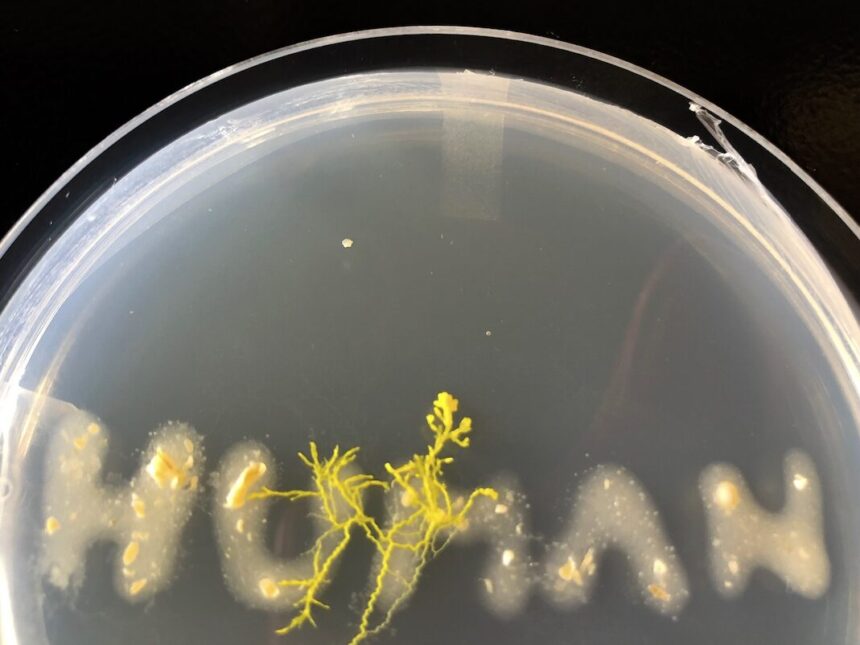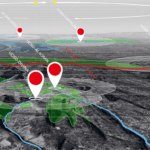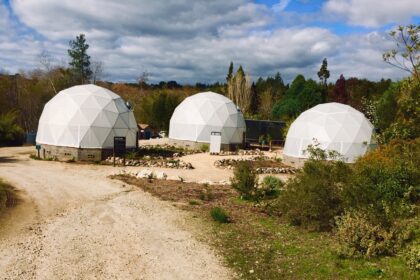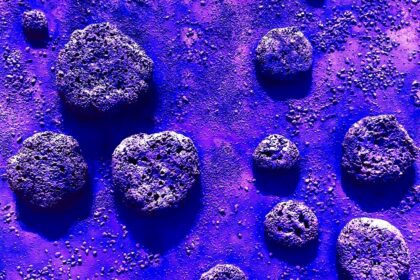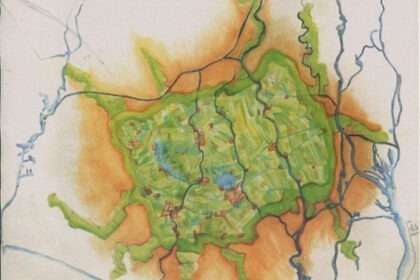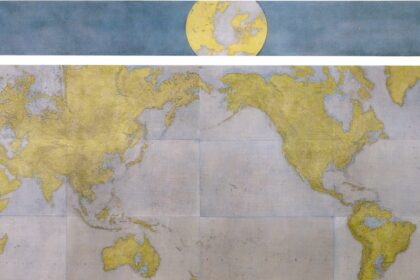Cesar & Lois: Listening to the Web of Life
Cesar & Lois (Lucy HG Solomon and Cesar Baio)
In this essay, we reflect on the Harrisons’ directive to listen to the “web of life” and we ponder how our artworks in some way are presaged by Helen and Newton Harrison, in dreams and conversations, almost a half-century before their conception. The poetic and critical content and the transformative impact of Helen and Newton Harrison’s creative output, considered alongside world systems theory and Indigenous scholarship of the global South, drive us as artists to imagine new futures. Those futures rest precariously in the ecosystemic relationships and societal entanglements that are part of “the web of life” – a phrase with more than one meaning. As artists, we are responding to distinct yet non-exclusive understandings of the web of life, a term used by different people in different fields at different times, including by Newton Harrison in the context of environmental art and public land interventions. We consider the web of life in various contexts and within our own work, as we build bio-digital networks and imagine AIs that learn from living networks—living, communication systems that can be considered intelligent, like Fungi and Physarum. Our hybrid perspective is that of a Californian and a Paulista, living and working as we do, respectively, in the border regions of California and the state of São Paulo in Brazil.
Newton Harrison describes the need for artists to join the web of life:
It is my opinion that our field needs to be trained in how to read the Life Web itself. After all, it continually speaks to us. And in reading this Life Web, we need to become obedient to its wishes. Its principle [sic] wish, from my perspective or my understanding, is that we the human race would do best to seek ways to join the Web, stop consuming it, but rather become niches in the Life Web which would then reinforce its evolution, but above all its ability to continue [1].
Helen and Newton’s “web of life” has produced a network of artists and ecological revolutionaries who strive to create connectedness, at times in alignment with ancestral communities, often in line with local constituents and their various communities, and almost always created in community [2]. Jason W. Moore broadens the “web of life” in a global historical context, linking climate and social crises and the brutality of slavery with the transformation of the planet and pointing to “climate class divide, climate patriarchy, and climate Apartheid” as causes of climate change [3]. The web of life, with the explosion of the human population and, with that, the reorganization of the planet—through extraction, global trade, and mass consumption—responds to a new pattern, with inputs and outputs that extend beyond organic metabolism and include unchecked human consumption. Macarena Gómez-Barris contextualizes extraction in a physical geography that layers global capital over ecosystems, but in a context where the intangibility of forests and life persist: “The intangibility of the forest metabolizes, grows, multiplies, and escapes the condition of monoculture, whose complexity forces consideration…[4].” These webs of life take into account capitalism’s reorientation of the living world to human intervention (and human enterprise). In what seems a parable for the future, Newton ponders the existential threat of capitalism for human beings and the planet:
It’s too simple to believe for most people… All species overproduce for survival reasons. Produce a million eggs, only a hundred will develop, a natural phenomenon that causes growth. If we harvest redundancy appropriately, we will assist in the health of ecosystems. For instance, if I have 1000 hectare of forest and I harvest on a 200-year basis. I only cut 20 hectare of trees any given year, so I harvest from different places, then biodiversity happens, [sic]
I as a human being can take that redundancy for my own benefit – I’ll take only the redundancy and only take in such a way that the forest improves. Otherwise I do not pull out the tree. And that’s the rule. That’s the wealth of our future: in nurturing the web of life and harvesting the excess to our benefit for trade and making sure that the harvest improves or at least sustains the systems. Right now, our harvest eats up the system. That’s my answer to capitalism. My second answer is if we don’t do it, we’re dead [5].
The Harrisons’ understanding of human and environment relationships reveals the ways that nonhuman entities and ecosystems deal with existential problems, or, in other terms, how ecosystems manage problems relating to their own permanence, without human interference. We are curious: how do other beings understand their environment, and do they ponder their own permanence? In Cesar & Lois artworks we contemplate how different organisms deal with problems in order to survive and how knowledge is transferred across the expansive web of life. In our hybrid art installation, Degenerative Cultures, the logic of living organisms becomes the basis for reformulating classical texts (see figure 1). In this and other living artworks, we aspire to learn from the web of life, the one that the Harrisons so clearly intuit.

As artists, we examine the power dynamics between globally connected human societies and nature, and we propose new ways of imagining human existence. Considering that globally connected societies have established systems in science and technology that hierarchize human logic and legitimize the transformation of nature into capital (distributed among very few people and concentrated in institutions who profit from those transformations), we have focused our attention on the intersections of technological and human networks within the web of life as a way to reconsider what it means to be human (and how to be human) amid anthropogenic ecological crises [6]. With artworks that seek to connect human and nonhuman intelligences with machine learning, we ask how art, science, and technology can respond to a world facing ecosystem collapse.
We, along with others who have similar interests in plant-based intelligence, envision technologies that bend to the web of life rather than rule over it. At this particular time of climate crisis, the confluence of creative ideas around post-anthropocentric technologies synchronizes our collective with a community of Brazilian artists who also connect human and nonhuman systems, including Giselle Beiguelman who traces the scientific names of plants to the history of colonialism [7], Guto Nóbrega who combines plant and machine signaling [8], and Clarissa Ribeiro who mingles human breath with the substance of cork trees [9]. In Porto Alegre, photographer Tuane Eggers carefully records the lives of mushrooms [10]. Another mycophile, curator Marcello Dantas creates spaces for artists to interact with living networks and grow their artworks [11]. These individuals in the global South, among many others across the globe responding in real-time to the climate crisis, are, in their own ways, working towards sustaining the web of life through concentrated human-environment interactions.
The sustenance of the web of life, according to Newton Harrison, requires that human societies reorient our knowledge and technology towards the “wealth of our future” [12]. That reorientation calls for measured growth—a limiting of production. The engine of production is arguably the largest threat to nonhuman beings and their networks. In our own artworks, we ponder how nonhuman networks function when the web of life itself is threatened, when the ecosystem bends towards blight, and when global production has moved into, taken over, and even removed ecosystems. Our work is a response both to a human network that has cut itself off from its own environment and to a global capitalist system that depends upon the mass extraction of nature’s resources. An overarching question for us is: How do we contextualize and reshape our humanness in the web of life? (See figure 2 for an interspecies probing of the word, human.).
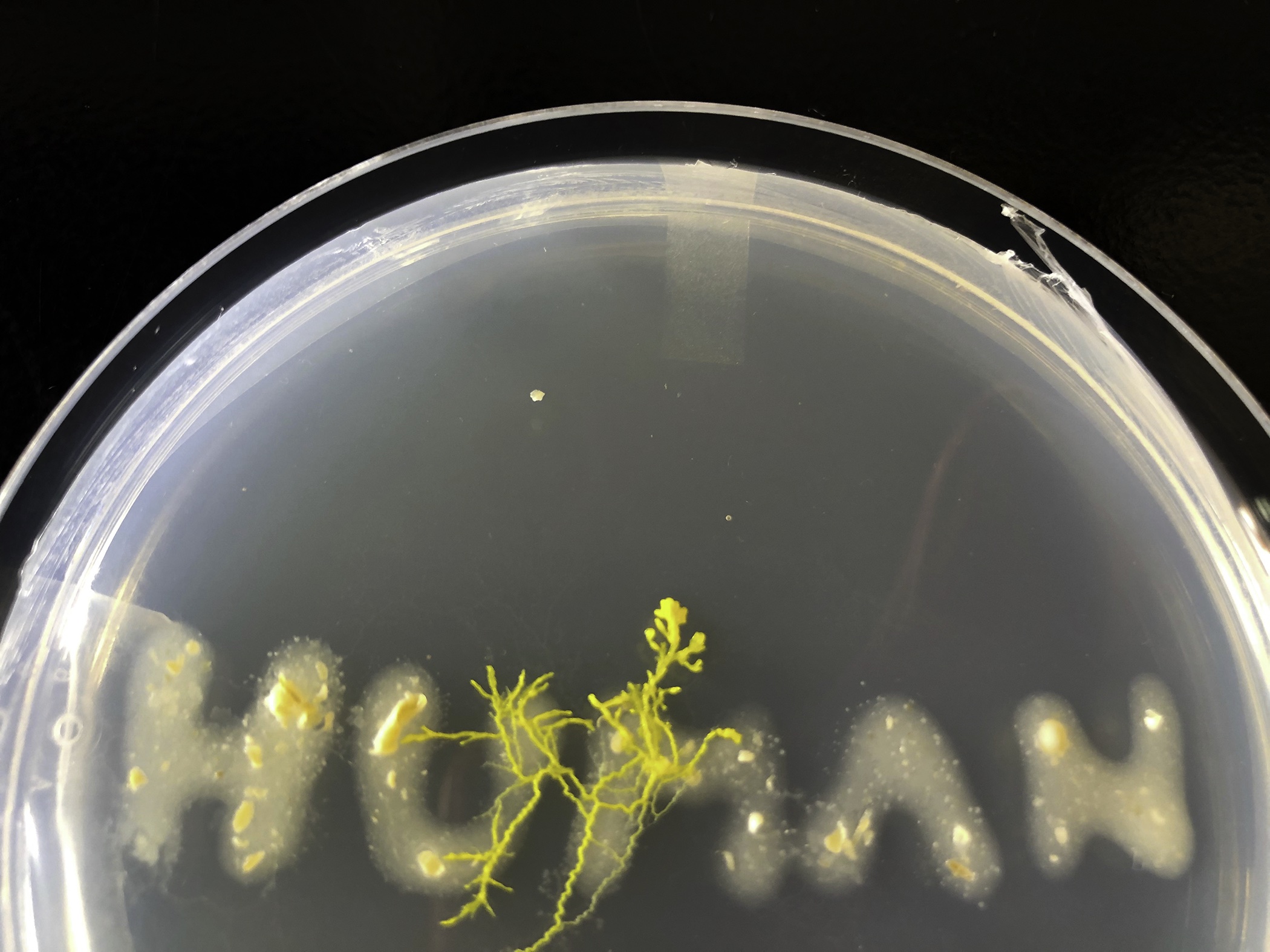
This urgent task to recontextualize our humanness within the web of life is a theme explored in the workshop, “Listening to the Web of Life,” organized by curators Tatiana Sizonenko and Heath Fox, who link this broader discussion to the work and vision of Helen and Newton Harrison [13]. Indeed, it could be argued that the web of life itself brought the many workshop participants together. Throughout the workshop, a room full of thinkers across the arts and the sciences, each grappling with their entangled webs of life, responded to the Harrisons’ work and discussed an array of art and science intersecting with ecosystems, while challenging one another to engage in the living world through art in (more) connected and vital ways [14].
For the Harrison’s, the web of life is the source and the material (at times the stage) of their artworks, which are grounded in local habitats, branching from Southern California and extending to the Netherlands, eventually reaching the distant areas of the lagoon cycle, ranging from Sri Lanka to the Pacific [16]. In the workshop, held on a cliff at the Scripps Institution of Oceanography overlooking the Pacific, Newton Harrison, conjuring Helen by quoting her dreams and referencing their conversations, shared the details of an ambitious artwork, called The Sensorium, that embodies the Earth’s vast oceans, where those who walk through it can speak with and learn from the vast intelligence that is the Ocean [15]. The Sensorium envisions the ocean as a source for machine intelligence. Newton Harrison discussed his plans for an oceanic AI, intended to speak with his voice as it answers questions about the ocean’s vast networks [17]. The project takes its form not only from the ocean but also from the Dalai Lama and consciousness. For the Harrisons, these are all interconnected, and they have been for some time. In their text, Newton and Helen detail their correspondence with the Dalai Lama: “It turned out that his [the Dalai Lama’s] middle name or hidden name was ‘Oceanic Consciousness’ (literally Ocean of Wisdom), and we in complete naivety had addressed him with that name!…
“To the Dalai Lama
We hold that the ocean is a great draftsman.
In response to our millennia of manipulation of fire,
The Ocean has answered gracefully…” [18]
What became clear in discussion with Newton Harrison is that his concept of the ocean as a consciousness, embodied in an AI based on the ocean, is only a beginning, and that a new consciousness is possible. In conversation, Newton explained how his and Helen’s thinking about this originated in Helen’s dream, which she had recounted to him and which they recorded as part of The Lagoon Cycle (see figure 3). In her dream, Helen observed various elements of nature and recognized among them an odd kind of dialogue. Afterward, she and Newton contemplated this nonhuman dialogue: “We understood the universe as a giant conversation taking place simultaneously in trillions of voices and billions of languages, most of which we could not conceive of even if we knew that they existed.” Each of their artworks was in fact an attempt towards greater comprehension, although not a direct attempt to acquire those languages: “…that would require reorienting consciousness around a different database [19].” Accessing the databases of nonliving beings, including species-specific signaling and the communication inputs and outputs of the web of life, is an objective for our art. As we (Cesar & Lois) shared our objective to orient artificial intelligence to the complex databases inherent in ecosystems, Newton delighted in how our art responds to Helen’s dream, almost half a century after she dreamt it. He explained that he spoke to Helen of us and our art a long time ago, before we had even conceived of it (before we were even conceived). The web of life was pulling at us and pushing us, and the creative context which entwines us in Brazil is intricately tied to California and to the Harrisons and their vibrant history of ecological art.

Our project of mycelial AI shares the ambition to route artificial intelligences to the web of life with the Harrisons’ project of an oceanic consciousness. Embedded in these art projects that propose ecologically oriented artificial intelligences are a series of questions. Why do programmers of artificial intelligence so frequently aim to mirror a human person? Why are AIs attuned to neuroprocessing? Furthermore, why base an AI’s logic exclusively on human language and human logic? Could an AI learn from the complex network of nonhuman ways of communicating and connecting? How could an AI based on nonhuman entities question human exceptionalism—an ecological egocentrism built in modernity and sustained through capitalism—and shift the power relationship between human beings and the living world? How can technologies that acknowledge nonhuman intelligence challenge the colonial impetus that establishes a hierarchy in the relationship between humanity and nature? We have been framing some of these challenges to human technology with the phrase “ecosystemic intelligence,” or an intelligence that takes into account the needs of ecosystems and their inhabitants [20]. An AI conceived in such terms follows the logic of living networks and the logic of the web of life.
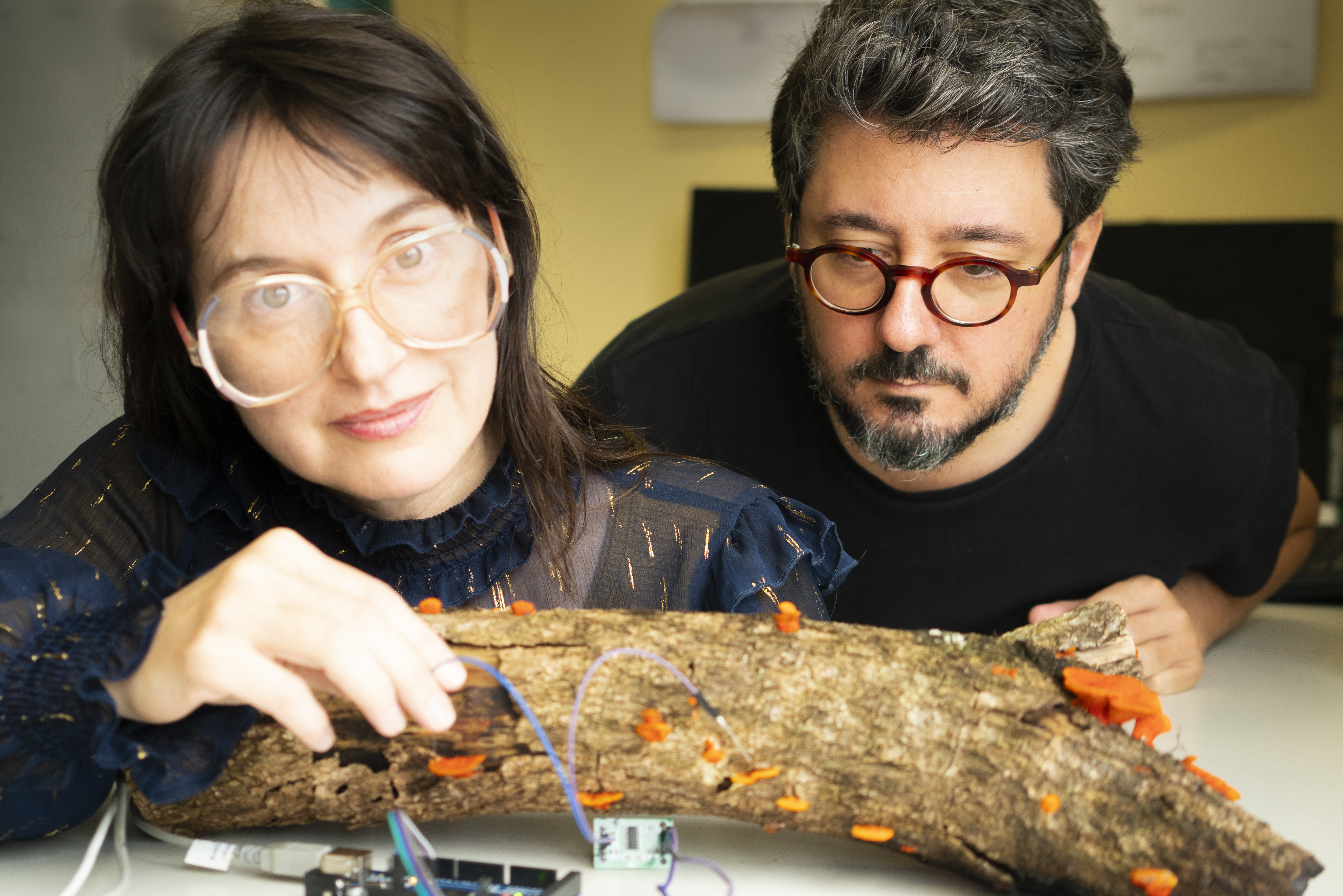
After the workshop, astrophysicist and art and science provocateur Roger Malina suggested that we turn our energies from the concurrence of ideas to a manifesto (The Harrisons, along with workshop attendees David Haley and Malina, have authored or coauthored manifestos at the juncture of art and science [21]). Malina envisions “An Open Observatory,” a manifesto that calls for an “intimate science that involves billions of people in understanding the world around them and their impact on it” [22]. This, too, is an attempt to speak the language of the web of life. In response to Malina, we considered a manifesto of the Ocean, written by the ocean with us as its signatories. Yet such an endeavor relies on our humanness, our interpretation of the ocean’s currents, its salinity, and its ebbs and flows. Could we possibly understand an ocean in agony?
Our current project requires us to listen in to the signaling of mycelia, or electromyceliograms—our name for the electronic pulses of fungal networks (see figure 4). In this context, we ask: If a mushroom manifesto is transmitted, would we understand its meaning? A manifesto is necessarily a function of bringing human beings’ intentions to the center; if we were to write one on behalf of a nonhuman entity, would this only place humans again at the center? How do we translate meaning between so radically different forms of life? These questions bring up problems that we probe in our works. In the context of the Anthropocene and the climate crisis, it seems to be more important to frame these questions not as an engineering or linguistic problem, which would lead to the elaboration of translation technologies or a grammatical equivalence between ways of communicating, but as a problem of relationships (and relating) among the many.
In Cannibal Metaphysics, Eduardo Viveiros de Castro juxtaposes this many against societal concepts of separateness, which he presents within the framework of multinaturalism: “Our macroconcept of nature fails to acknowledge veritable plurality, which spontaneously forces us to register the ontological solecism contained in the idea of ‘several natures’ and thus the corrective displacement it imposes.” In contrast, “…Amazonian multinaturalism affirms not so much a variety of natures as the naturalness of variation—variation as nature [23].” From both a political and poetic point of view, it seems that the most important thing in the proposal of a translation between radically different alterities is the recognition of nonhuman alterity as a form of knowing that acts in the systems of which it is a part, something close to what Viveiros de Castro understands as “several natures.”
Perhaps there are no equivalencies across our many natures within ecosystems. Certainly, the “sense” of the ocean or the microorganism is not the same as human “meaning,” but that does not mean that these beings do not contain memory or make decisions based on tangible information, such as in response to environmental and chemical inputs [24]. Seeking a human meaning in any manifestation of signaling received from these entities anthropomorphizes the nonhuman, but proposing a poetic endeavor to listen to these beings seeks, above all, to recognize in these entities an existence equivalent to that of a human being, to give them the right of expression and, in the most basic sense, to acknowledge their will to continue to exist. Perhaps the most important thing is not to find a grammar capable of organizing the other’s language (a mushroom colony’s language, for example) in a strict sense, but one that manages to translate the interest we have in knowing the other and considering the other an equally important entity in the web of life. For this reason, in our works, we do not seek to interpret received information as intelligible messages from a non-human entity (intelligible to humans, that is). We seek to create a hybrid visual or textual piece, impossible to be fully understood in human languages. What results from these works almost always resembles error, something incomplete or noisy, yet, despite not having complete sentences, the error becomes pregnant with meaning as a result of an encounter between such different forms of existence. So, if the Ocean’s manifesto is transmitted and we likely won’t understand its meaning, we can still ask: What are the meanings that we can give to the ocean when it agonizes?
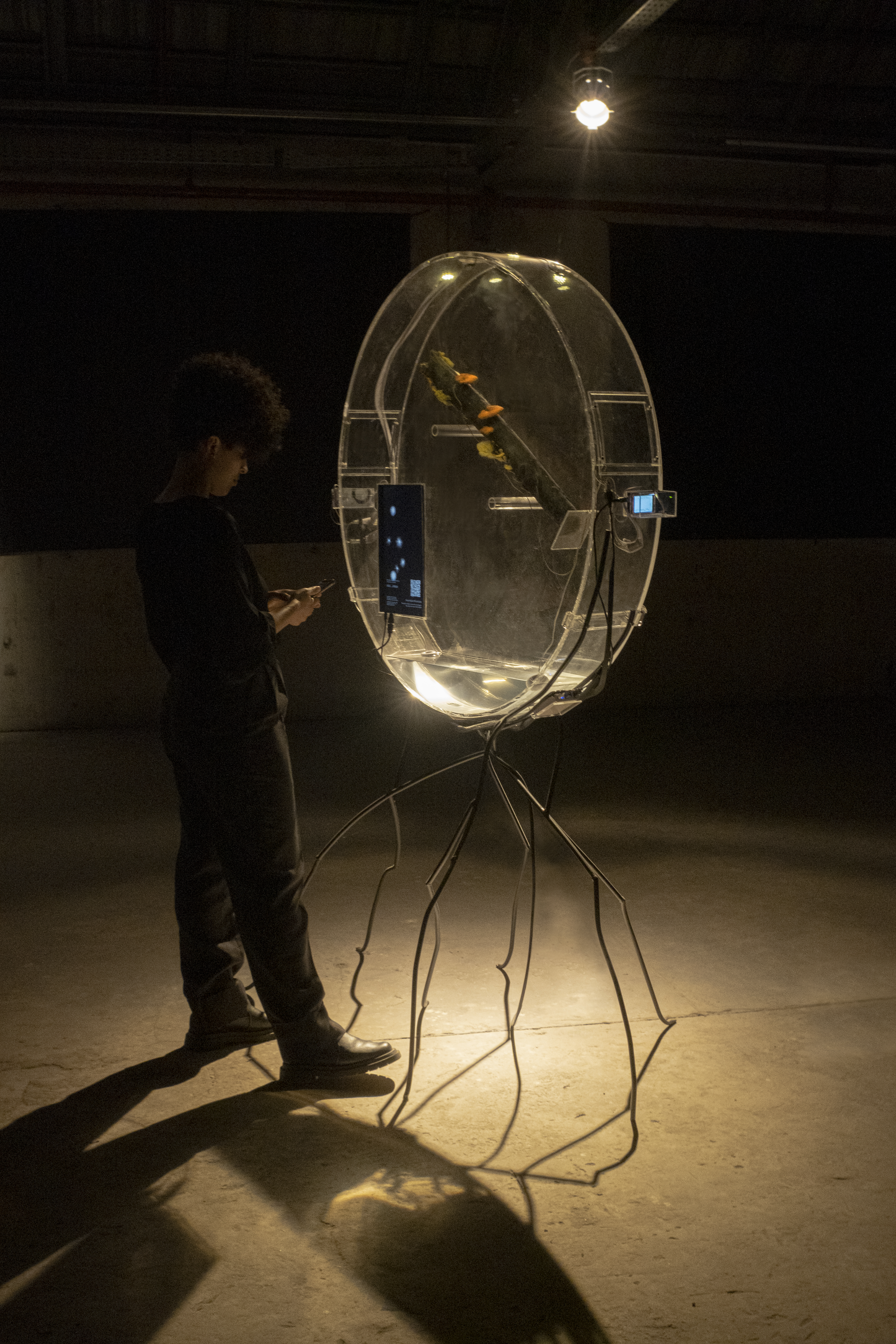

Cesar & Lois advance intersections between natural, societal and technological networks and often work alongside scientists to imagine new futures. Their society-microbiome-technology collaborations result in artworks in which prehuman logic and posthuman logic (growing microorganisms and machine thinking) work together to critique anthropocentric perspectives of nature. Their prototypes of bio-digital networks require art with science, including field and laboratory work. Studying lichens up-close, the duo seeks to understand time from another perspective, which becomes the pulse of one node in an ecosystemic artwork. Nurturing mycelia in philosophy texts, Cesar & Lois ponder how to “think like a mushroom” and propose an AI that eats the Anthropocene. Cesar & Lois were recipients of the 2018 Lumen Prize in AI and were selected for Singapore’s Global Digital Art Prize biennial in 2019, the Aesthetica Art Prize exhibition in the UK in 2021, and the Mercosul Biennial in Brazil in 2022.
Based in California and Brazil, the art duo consists of Lucy HG Solomon and Cesar Baio. Lucy HG Solomon is a Fulbright scholar whose global project probes microbiological connections across distant terrains. An educator in the Department of Art, Media, and Design at California State University San Marcos, she leads the DaTA Lab (Laboratory for Data and Transdisciplinary Art). Cesar Baio is a CAPES (Coordenação de Aperfeiçoamento de Pessoal de Nível Superior) scholar whose postdoctoral work at i-DAT (Institute of Digital Art and Technology) at Plymouth University focuses on data and the city. He is an educator in the area of art and technology at Universidade Estadual de Campinas (UNICAMP) and the director of actLAB (Laboratório de Pesquisa em Arte, Ciência e Tecnologia).
Notes
[1] Alexander I. Kopytin and Stephen K. Levine, “An interview with Newton Harrison,” Ecopoiesis: Eco-Human Theory and Practice, vol. 2, no. 1 (2021). URL: https://en.ecopoiesis.ru/interviews/article_post/an-interview-with-newton-harrison DOI: 10.24412/2713-184X-2021-1-74-82
[2] See one example of the community of ecological artists around the Harrisons in the workshop, “Listening to the Web of Life,” an interdisciplinary workshop organized by Tatiana Sizonenko and Heath Fox, La Jolla Historical Society and Scripps Institution of Oceanography (March17-18, 2022). URL (scroll for video links): https://lajollahistory.org/exhibitions/helen-and-newton-harrison-california-work
[3] Jason W. Moore, “How Not to See Like an Empire: Imperial-ism, Anti-Imperialism, and the Perils of Green Thought,” plenary talk, Imperialism and Anti-Imperialism in the Web of Life, 7th Annual Conference of the World-Ecology Network, (Online, October 22, 2021).
[4] Macarena Gómez-Barris, The Extractive Zone: Social Ecologies and Decolonial Perspectives (Durham, NC: Duke Univ. Press, 2017), p. 18. DOI: 10.2307/j.ctv1220n3w
[5] Koptytin and Levine, “An interview with Newton Harrison.”
[6] Lucy HG Solomon, Cesar Baio, Cesar & Lois, “When Do We Stop Being Human?: Prefiguring Nonanthropocentric Thinking.” Leonardo, vol. 55, no. 5 (2022): pp. 445-450. DOI: 10.1162/leon_a_02246
[7] Botannica Tirannica – Giselle Beiguelman (2022), Museu Judaico, São Paulo, Brazil, May 28-September 18, 2022.
[8] Guto Nóbrega. “Hybrid Ecologies: Interactions Between Artificial and Natural Organisms in Telematic Environments.” Visualidades (Goiânia, Brazil) vol. 9, no. 2, 2011: pp. 75–89.
[9] Inhaling Consciousness, Clarissa Ribeiro (2019) in Sentient States: Bio-Mind and Techno-Nature, Universidade Católica Portuguesa, Porto, Portugal, June, 2019.
[10] Fluxus Fungus, directed and filmed by Tuane Eggers (2020).
[11] Aimee Farrell. “Inside the Guggenheim of the Jungle,” Financial Times, February 3, 2022. URL: https://www.ft.com/content/888c6bc4-5ea1-40a8-a18b-870dca2015df
[12] Koptytin and Levine, “An interview with Newton Harrison.”
[13] Tatiana Sizonenko and Heath Fox, “Listening to the Web of Life.”
[14] See the discussion directly following Newton Harrison’s talk, “To Give Back More Than We Take, A Sensorium for the World Ocean,” “Listening to the Web of Life,” interdisciplinary workshop, La Jolla Historical Society and Scripps Institution of Oceanography (March 18, 2022). URL: https://youtu.be/C52EN5SNjn8?t=11067
[15] Newton Harrison, “To Give Back More Than We Take, A Sensorium for the World Ocean,” “Listening to the Web of Life,” interdisciplinary workshop, La Jolla Historical Society and Scripps Institution of Oceanography (March 18, 2022). URL: https://youtu.be/C52EN5SNjn8?t=8427
[16] Lagoon Cycle, Helen Mayer Harrison and Newton Harrison (1974-1978).
[17] Newton Harrison, “To Give Back More Than We Take, A Sensorium for the World Ocean.”
[18] Helen Mayer Harrison and Newton Harrison,The Time of the Force Majeure: After 45 Years Counterforce is on the Horizon, edited by Petra Kruse and Kai Reschke (United Kingdom: Prestel Publishing, 2016).
[19] Helen Mayer Harrison and Newton Harrison, “Shifting Positions Toward the Earth: Art and Environmental Awareness,” Women, Art, and Technology, edited by Judy Malloy (Cambridge, MA: MIT Press, 2003), p.161.
[20] See the authors’ article on framing AI as ecosystemic, with the capacity of embracing the whole planet. Lucy HG Solomon and Cesar Baio, “An Argument for an Ecosystemic AI: Articulating Connections Across Prehuman and Posthuman Intelligences,” International Journal of Community Well-Being, edited by Bogdana Rakova et al., vol. 3, mo. 4 (Springer, 2020), pp. 1-26. URL: https://www.ncbi.nlm.nih.gov/pmc/articles/PMC7649898/ DOI: 10.1007/s42413-020-00092-5
[21] See the following manifestos: Harrison Studio Manifesto, Helen Mayer Harrison and Newton Harrison, URL: https://theharrisonstudio.net/a-manifesto-for-the-21st-century; An Open Observatory Manifesto, Roger Malina (January 9, 2010), URL: https://www.leoalmanac.org/an-open-observatory-manifesto-by-roger-malina/; We Assert, the manifesto of CIWEM’s (The Chartered Institution of Water and Environmental Management) Arts and Environment Network (AEN) (2012), URL: https://www.artdotearth.org/pdf/WE_ASSERT.pdf
[22] Lanfranco Aceti. “An Open Observatory Manifesto by Roger Malina,” Leonardo Electronic Almanac (May 14, 2018). URL: https://www.leoalmanac.org/an-open-observatory-manifesto-by-roger-malina/.
[23] Eduardo Viveiros de Castro. Cannibal Metaphysics. (Minneapolis: University of Minnesota Press, 2015), p. 74. URL: https://doi.org/10.5749/j.ctt17xr4vt.
[24] See the authors’ article that explores nonhuman logical systems as valid models for decision-making. Lucy HG Solomon and Cesar Baio, “An Argument for an Ecosystemic AI: Articulating Connections Across Prehuman and Posthuman Intelligences,” International Journal of Community Well-Being.”

